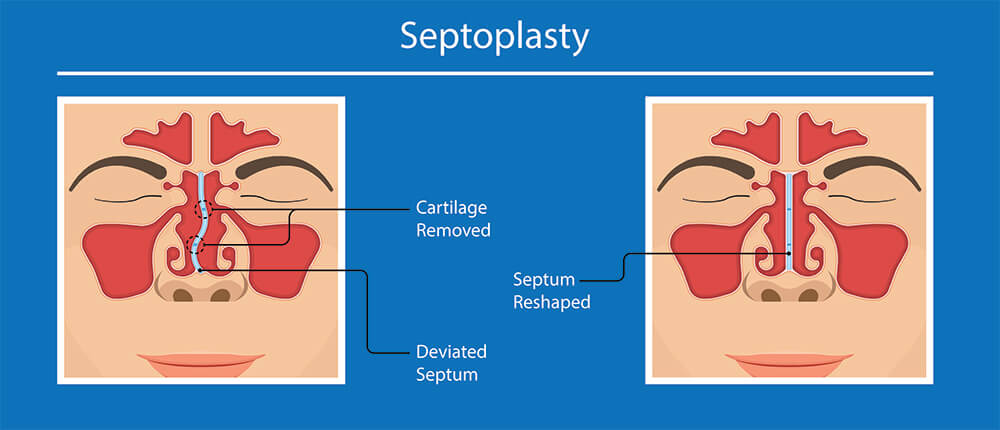SEPTOPLASTY
WHAT IS SEPTOPLASTY?
The septum is the wall of bone and cartilage that divides your nose into two separate nostrils. A deviated septum occurs when your septum is moved to one side of your nose.
Septoplasty is a surgical procedure to correct a deviated septum. Septoplasty straightens the septum, allowing for better airflow through your nose.
PREPARING FOR A SEPTOPLASTY
ANESTHESIA: septoplasty can be done under local anesthesia, which numbs the area to prevent pain. However, most people have the surgery under general anesthesia, which means they’re asleep during the procedure.
SEPTOPLASTY PROCEDURE
TIME TAKEN : septoplasty takes anywhere from 30 to 90 minutes to complete, depending on the complexity of the condition.
In a typical procedure, the surgeon makes an incision on one side of your nose to access the septum. They next lift up the mucous membrane, which is the protective covering of the septum. Then the deviated septum is moved into the right position. Any barriers, such as extra pieces of bone or cartilage, are removed. The last step is the repositioning of the mucous membrane.
You may need stitches to hold the septum and membrane in place. However, packing the nose with cotton is sometimes enough to keep them in position.
POTENTIAL RISKS OF A SEPTOPLASTY
- bleeding
- scarring
- perforation of your septum, which happens when a hole forms in your septum
- an altered nose shape
- a discoloration of your nose
- a decreased sense of smell
Excessive bleeding and infection are possible risks of any surgery. Keeping your nose clean and washing your hands frequently can reduce these risks.
RECOVERING FROM A SEPTOPLASTY
Septoplasty is usually performed as an outpatient procedure unless major complications arise. This means that you’ll be able to go home on the same day as the procedure, once the anesthesia has worn off. Your nose will be swollen, painful, and packed with cotton to control bleeding. The packing can be removed a day or two after surgery. Your doctor will also prescribe pain medication as needed.
You should also limit your physical activity for several weeks after surgery to minimize swelling and promote healing.
Tips for a quicker recovery include :
- elevating your head at night to keep the swelling down
- not blowing your nose for at least three days after surgery
- wearing shirts that button up in the front so you won’t have to pull clothing over your head.
FUNCTIONAL ENDOSCOPIC SINUS SURGERY
PICTURE OF FESS SURGERY
Functional endoscopic sinus surgery is a minimally invasive technique used to restore sinus ventilation and normal function.
ANESTHESIA : The procedure can be performed under general or local anesthesia on an outpatient basis, and patients usually experience minimal discomfort.
CANDIDATES FOR SINUS SURGERY
FESS (like any sinus surgery) is most successful in patients who have recurrent acute or chronic infective sinusitis.
A CT scan before FESS is mandatory to identify the patient's ethmoid anatomy and its relationship to the skull base and orbit. CT scanning also allows the extent of the disease to be defined, as well as any underlying anatomic abnormalities that may predispose a patient to sinusitis.
Patient selection therefore involves a thorough history and physical examination, a trial with medical treatment and, finally, CT scanning.
The result is a highly selected group of patients who can expect improvement of up to 90 percent in their symptoms.
BASICS OF FESS :
Obstructions in the ethmoid sinus region can also affect the maxillary, frontal, and sphenoid sinuses.
When an otolaryngologist (ENT specialist) performs surgery in the ethmoid sinus region, the goal is usually to remove obstructions that block natural drainage and create an increased risk of infection, a well as to remove inflamed tissue and bone. Endoscopic sinus surgery offers a way to clear blockage while disturbing as little healthy tissue as possible.
Because it is less invasive than other surgical methods, it increases the chance of rapid recovery. The doctor may also recommend endoscopic surgery to remove polyps or to straighten the septum.
TIME AND STAY
Endoscopic surgery is typically performed either as an outpatient procedure or with an overnight hospital stay. The surgery usually lasts from one to three or more hours, and the patient may receive general anesthesia or, less commonly, sedation through local anesthesia
POSTOPERATIVE INSTRUCTIONS
After surgery, the sinus is packed with temporary sponges or sterile packing at the surgical site, but the nose itself may be completely packed.
Pain after surgery is usually mild. You can anticipate an early return to work, although you may feel tire and should restrict activity somewhat for a week or two. Full recovery takes several weeks, and severe inflammation may take months to settle down completely. That is why continued medical therapy following surgery is essential. Expect dried blood, mucus and crusting to occur inside the nose. Your doctor may recommend nasal irrigation or salt-water sprays and antibiotic lubricants to facilitate normal sinus activity.
Complications That May Occur Following Endoscopic Sinus Surgery :
- Infection
- Bleeding
- Recurrence or Persistence of Disease
- Voice Change
- Injury to the Eye
WHY CHOOSE US??
Alvura which is renowned for its state-of-the-art acclaimed services, offers you affordable and latest nasal ailments. We provide you the best and most recent surgical technology. We individualize each and every patient’s need and treat them accordingly. We want you to be comfortable and reassured about every before and after facts. Request a consultation right : Book an appointment


 Call Now
Call Now Whatsapp
Whatsapp Book An Appointment
Book An Appointment